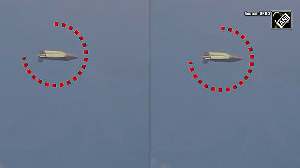 The Economic Survey tabled in the Lok Sabha on Friday by Finance Minister Pranab Mukherjee notes that the net capital flows at $36.7 billion in April-September 2010 were higher vis-a-vis $23.0 billion in April-September 2009.
The Economic Survey tabled in the Lok Sabha on Friday by Finance Minister Pranab Mukherjee notes that the net capital flows at $36.7 billion in April-September 2010 were higher vis-a-vis $23.0 billion in April-September 2009.
All components showed improvement with the exception of FDI and banking capital in the first half of 2010-11.
Net FDI into India moderated to US$ 5.3 billion as against $12.3 billion in April-September 2009.
Portfolio investment, mainly FII inflows, however, witnessed large net inflows of $23.8 billion ($17.9 billion in April-September 2009).
Despite significant increase in capital inflows, accretion to reserves during April-September 2010 was lower, mainly due to more than doubling of current account deficit compared to last year.
The Survey further notes that during April-September 2010, the trade deficit on balance of-payments basis stood higher at $66.9 billion as compared with $55.9 billion in the corresponding period last year.
This was mainly due to significant increase in imports that was in line with robust domestic economic performance.
In fiscal 2010-11, India's foreign exchange reserves have increased to $299.2 billion at the end of January 2011.
Beginning from a low level of $5.8 billion at the end of March 1991, the reserves were $279.1 billion at the end of March, 2010.
India's external debt has remained within manageable limits, reflecting the impact of the prudent external debt management policy of the government that emphasizes raising sovereign loans on concessional terms with longer maturities, regulating external commercial borrowings through end-use and all-in-cost restrictions, rationalising interest rates on NRI deposits, and monitoring long- as well as short-term debt.
At the end of September 2010, external debt stood at $295.8 billion, recording an increase of 12.8 per cent over the level of end-March 2010.
The rise was largely due to higher commercial borrowings, short-term trade credits, and multilateral government borrowings.
The share of commercial borrowings stood highest at 27.8 per cent in the total external debt followed by NRI deposits (16.9 per cent) and multilateral debt (15.8 per cent).
The maturity profile of India's external debt indicates the dominance of long-term borrowings with long-term debt accounting for 77.7 per cent of the total external debt.
As regards the World Economy, the Survey observes that the buoyant economic activity in emerging economies is gradually recovering from the crises.
The risks, however, remain, as advanced economies face large fiscal deficit, high public debt and unemployment levels, and tepid aggregate demand, leading to subdued growth.
Against this backdrop, the Indian economy continues to exhibit resilience, moving steadily back towards its pre-crisis growth path.
The developments in the external sector of the economy, however, indicate the widening of current account deficit due to robust import demand resulting from strong domestic economic activity and lower invisibles surplus.
The current account deficit, nevertheless, is being largely financed by the relatively higher capital flows, leading to moderate accretion in reserves.
There are, however, challenges that include the volatile nature of FII that is characterized by surge and reversal of capital flows, deceleration in FDI and the risk of further slowdown in advanced economies that may affect exports and strain balance of payments.
Source: PIB







 © 2025
© 2025